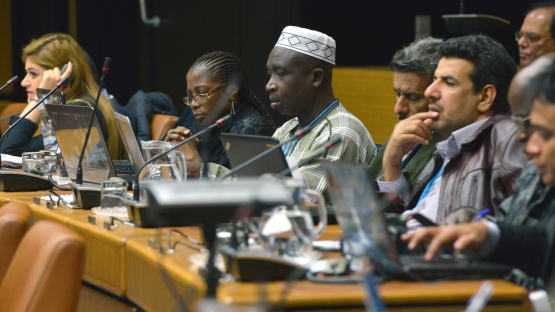The internet has opened new avenues for accessing information, exchanging knowledge and facilitating dialogue worldwide. Quick access to vast pools of knowledge and information through digital communication help foster progress in many areas, including the peaceful uses of atomic energy and nuclear technologies. One of the latest examples of this, the IAEA web-based platform CONNECT, was officially launched on 28 October 2014 at an event held at IAEA Headquarters in Vienna.
Providing an easy-to-use, members-only online environment that brings together existing and planned professional and expert networks, CONNECT facilitates collaboration and the sharing of information and experience across the nuclear field. Hosted by the IAEA on behalf of its Member States, the platform is intended to serve as a central location for connecting individuals as well as complementing existing training workshops and meetings that relate to the peaceful applications of nuclear science and technology.
"This is a platform created by you and for you," said Kwaku Aning, IAEA Deputy Director General and Head of the Department of Technical Cooperation. "CONNECT can only grow and add value if Member States embrace it and contribute to it by sharing information and knowledge," he said. He also added that CONNECT was an example of the successful cooperation between the IAEA and the European Commission (EC), and their joint efforts with Member States to pursue a common goal.
Juan Carlos Lentijo, Director of the IAEA Division of Nuclear Fuel Cycle and Waste Technology, said CONNECT was one of the key tools that the Agency was offering to its Member States. "This platform not only delivers quality materials at no cost to Member States, but also offers the nuclear community a tool to improve communication and how knowledge is served and managed," he said.
The CONNECT launch kicked off a three-day workshop from 28 to 31 October 2014 that brought together more than 100 participants from Africa, the Asia/Pacific region, Europe and Latin America. This interregional event focused on training individuals from Member State organizations who have committed to assisting the IAEA in developing and utilizing CONNECT. The workshop familiarized participants with the new platform, its functionality and how to effectively promote its use in participants' home countries.
CONNECT was originally expected to launch with five networks, but the strong interest in the online platform led to 11 networks participating in its debut. The networks focus on a range of nuclear areas, from safety to education, and individuals and organizations can apply to join them at no cost. Once in a network, a user can build a profile to access resources such as e-learning materials, expert contacts, discussion forums, training courses, publications and multimedia libraries. There are already plans for adding three new networks.
The active participation of CONNECT users, whether by uploading new materials, joining discussions or providing feedback, will make the platform a viable, vibrant and effective tool. Moderators and IAEA Scientific Secretaries complement user contributions by helping to oversee and monitor the platform to ensure the quality of the online environment.
"CONNECT proves that cooperation between the European Commission and the IAEA delivers concrete results that are available to everyone, everywhere," said Jorge Tanarro-Colodron, from the EC Joint Research Centre in Petten. "Launching CONNECT is a first step in a very interesting and cooperative journey."
Background
The CONNECT project was implemented in two complementary parts: the EC financed the development of the platform and most of the currently available e-learning material, while an IAEA technical cooperation project (INT9174 - Connecting the Network of Networks for Enhanced Communication and Training) supports capacity-building on using the platform. CONNECT is managed by the IAEA Department of Nuclear Energy, with support from the IAEA Department of Technical Cooperation. The platform's current 11 networks focus on beta-delayed neutron emission, uranium legacy sites, low level radioactive waste disposal, environmental remediation, instrumentation and control systems, decommissioning, radioactive waste characterization, nuclear management systems, nuclear knowledge management, spent nuclear fuel management as well as geological disposal.




